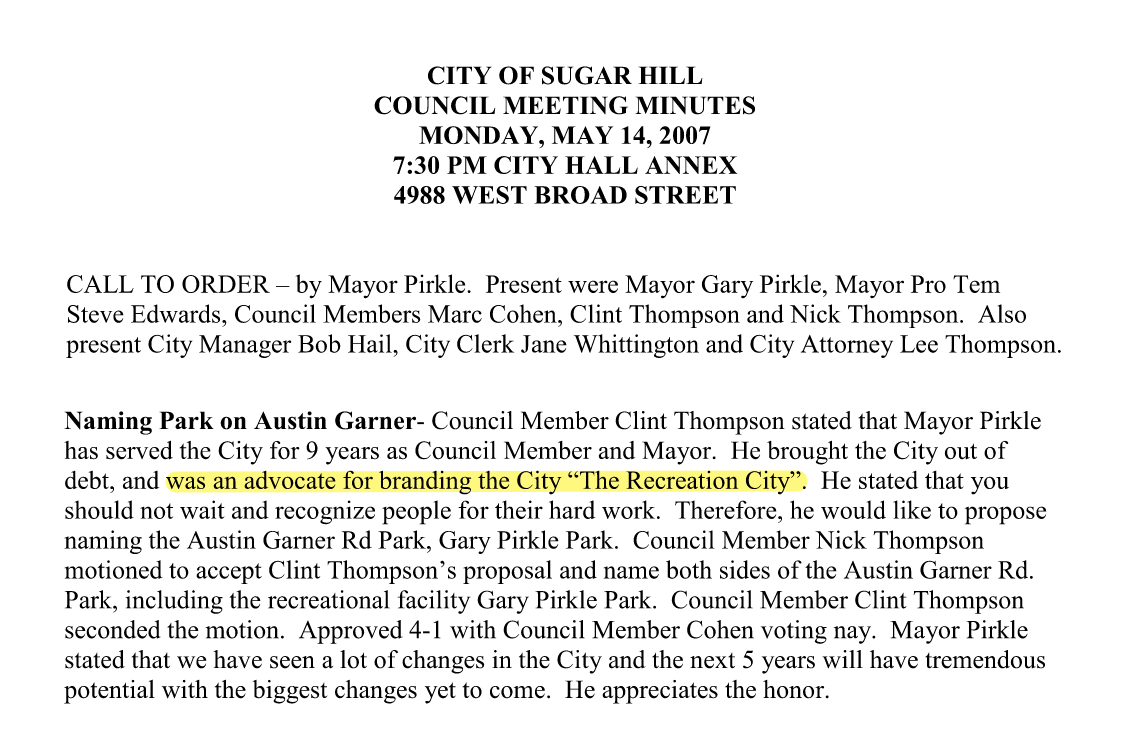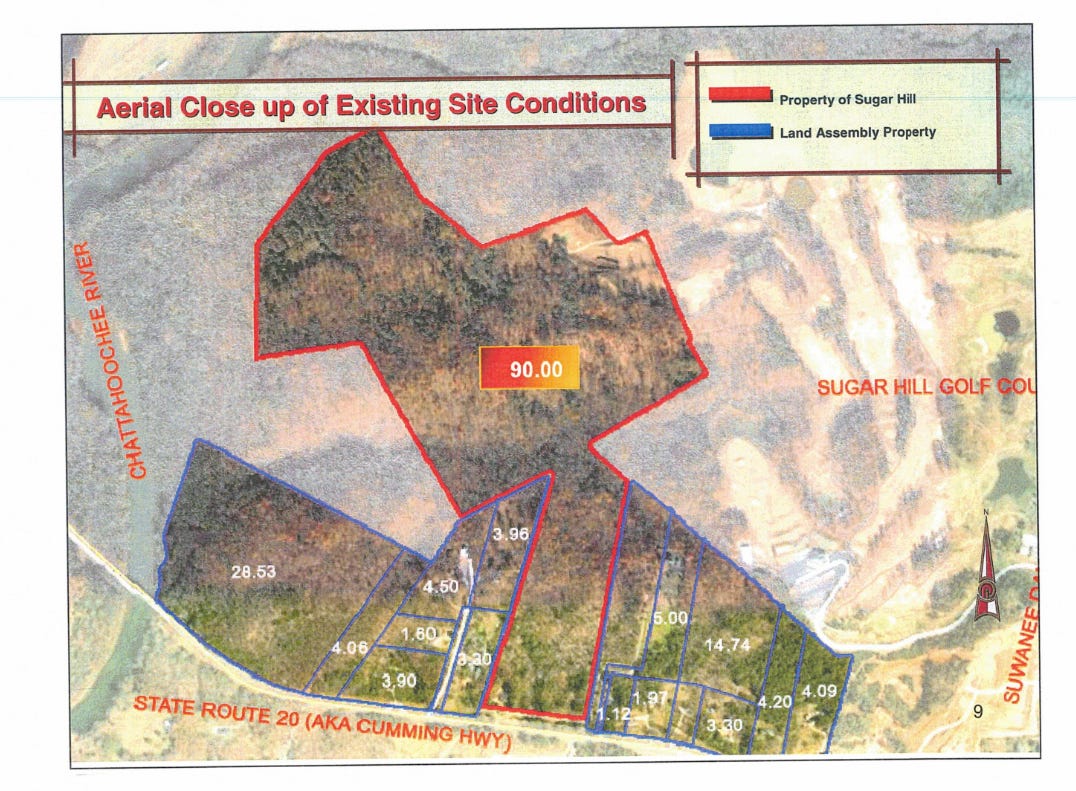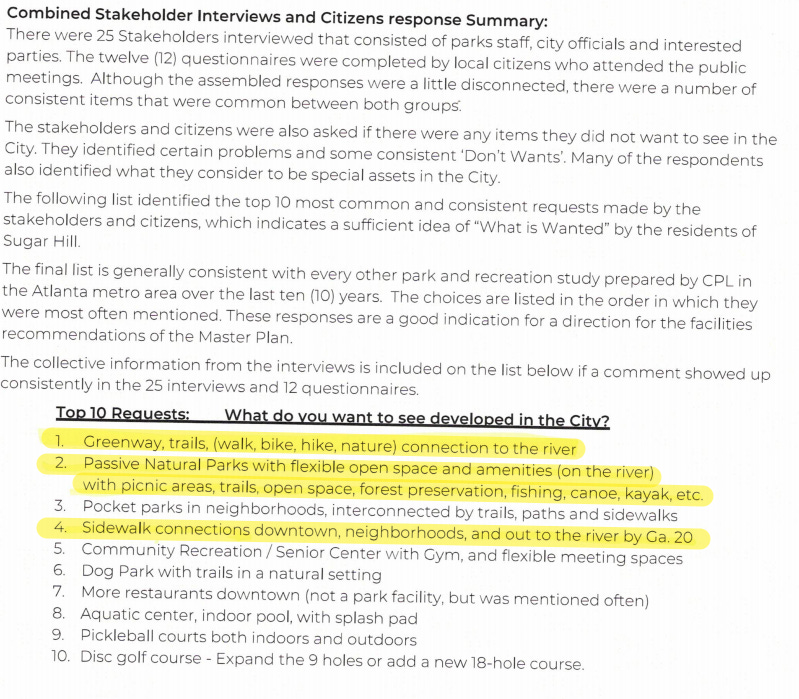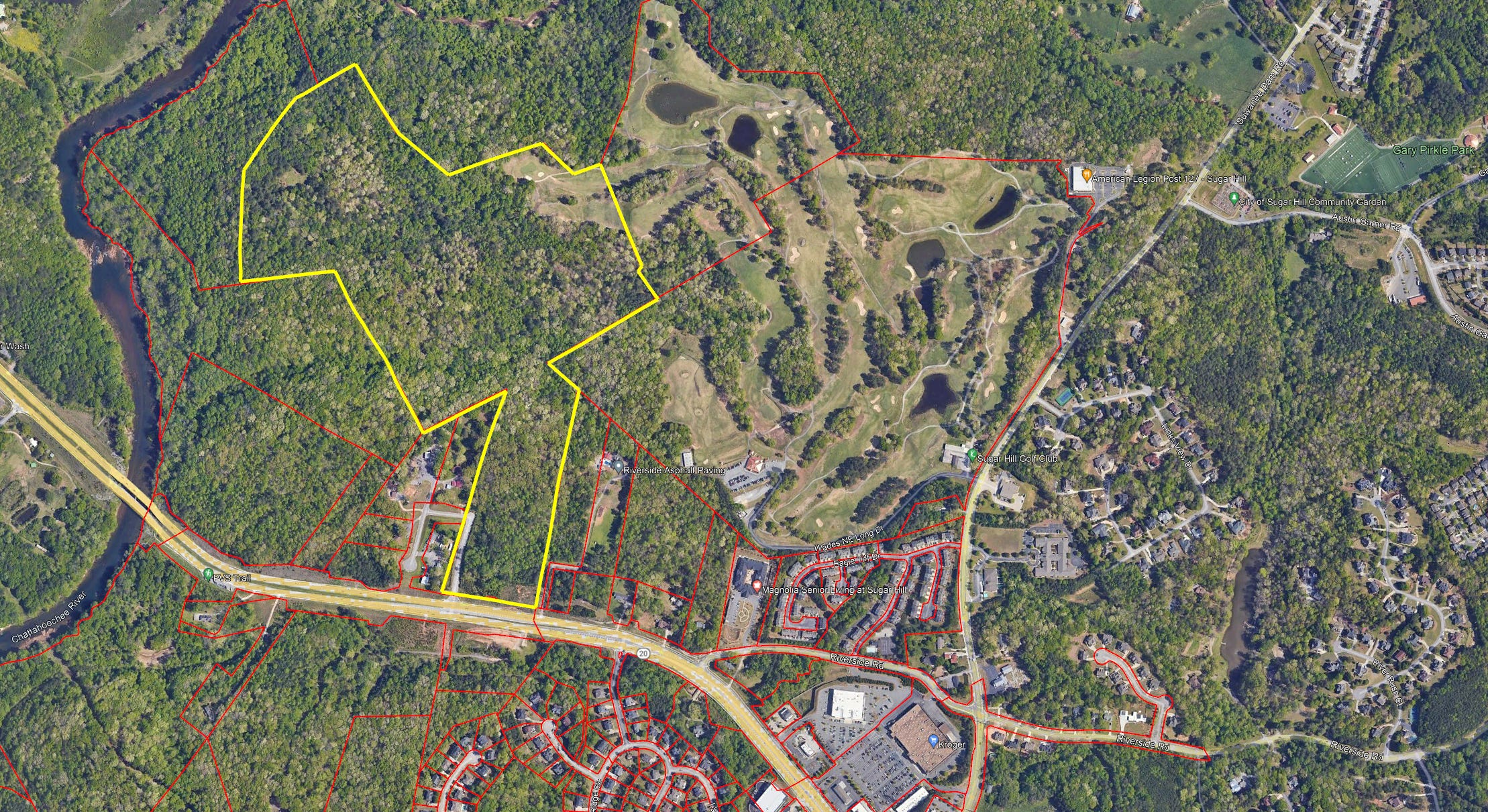The Riverlands - Now and What Almost Was - The North Tract
Sugar Hill has a unique opportunity to give the community access to property near the Chattahoochee River. And then there was that time the city tried unloading the property for $50 to a developer.
The Riverlands Authority was founded in late 2022 with the goal of activating and providing public access to city owned property near the Chattahoochee River adjacent to the National Park Service’s Chattahoochee River National Recreation Area. This unique opportunity was made possible by land acquisitions made in 1988 for a close to 268-acre tract north of Highway 20 and an approximately 70-acre tract acquired in 2015 south of Highway 20.
The focus of this article is the north tract.
The purpose of this article is to focus on what the city had contracted to build on the property in 2007 (and renewed the contract in 2009 and 2011) that would have been FAR different than what is envisioned for the property today. It was only through the inability to finance the project as a result of the Great Recession that the property isn’t a giant parking field, big box retail, hotel and soccer fields - completely devoid of the special character of the property as it sits today.
Of the 268-acre total north tract, close to 170 acres were developed into the Sugar Hill golf course in 1992 and used as a greywater spray field for a number of years. In fact, much of the remaining north tracts also was used as a spray field and is littered to this day with abandoned spray field equipment. Greywater is partially treated sanitary sewer wastewater that is fit for irrigation but not potable water for consumption or bathing. Where the current American Legion Post 127 stands previously was the location for a water treatment facility for much of the city.
The city sold its sewer system several years ago to Gwinnett County and the water treatment plant was shuttered. The golf course and woodlands remained a spray field for partially treated water for many years afterwards until Gwinnett County rerouted all of its greywater to the F. Wayne Hill Water Treatment Plant a few years ago as part of the “Water Wars” lawsuit with Florida and Alabama.
While the golf course still operates today, a nearly 100-acre tract remains.
Over the years, a number of potential uses for the property have been considered. The most consequential and only real proposal for the property happened in 2007 when the city approved a contract without any public input with Global Sports for the development of a “downtown” (Global Sports term used in their presentation - see later in the article) that would have been a massive development of commercial, housing and recreation fields that would have completely cleared and graded the property.
At the time, the city was attempting to brand itself “The Recreation City” from a 2010 AJC article regarding the opening of Gary Pirkle Park:
Nearly a year ago, the Gwinnett enclave of 17,000 started marketing itself as "The Recreation City."
"We didn't just pick something out of the air and make that our slogan and try to become that," said Mayor Gary Pirkle, whose name graces the entrance to the park. "It became very obvious to us that this is what we are ... . The park is an extension of that."
The idea of Sugar Hill marketing itself as “The Recreation City” began back at least in 2007 when Gary Pirkle Park, then referred to as “Austin Garner Road Park” was named after then Mayor Gary Pirkle. There was no plan or any explanation where the idea for marketing the city as “The Recreation City” came from or what the plan was to move forward on expanding recreation assets in the city would be or what the purpose of marketing itself this way would be. For example, was it to draw tourists to the city? If so, the city didn’t contain any hotels for them to stay at. There wasn’t a clear plan or desired outcome of this marketing effort as it pertains to recreation.
From the minutes from May 14, 2007:

As an apparent part of the expansion of the city as “The Recreation City”, in November 2007 the city voted to enter a 50-year lease at $1 per year ($50 total) with Global Sports for the north tract to be developed into 8 soccer fields, a 10-12,000 seat stadium, family athletic and wellness center as well as walking trails. This was done without public input or public comment. (Note that the city would have received 1% of the gross revenues after the 3rd year had the project actually been realized but had turned over the control of the property for $1 a year to Global Sports.)

The city began to really move forward on the marketing of the city as “The Recreation City” in 2009, with the city newsletter “Sugar Hill Sentinel” headlining the branding efforts in April 2009.

Importantly just a month prior to this article, in March 2009 the city extended the contract with Global Sports for the development of the property.

Following this, in June 2009, then Mayor Gary Pirkle discussed the marketing efforts in his monthly report.

The city had apparently gone all in with “The Recreation City” and the development of north tract was a key component to realizing that effort.
So, what, exactly, was Global Sports vision for the property? We saw bits and pieces of what that would be through the minutes and contracts but nothing that gave an overall scope of the project.
The answer to that question was provided in a presentation that Global Sports made to Mayor and Council at the time. Below is a selection of the more relevant slides from the presentation. The entire presentation is included at the end of the selection of slides included in this article.

In the “aerial close up” slide, Global Sports was looking to develop not just the 90 acres owned by the city, but an additional 84 acres adjacent to the city owned property along Highway 20.

In totality, Global Sports proposed to clear the entire property. They proposed to build, using their description, a “downtown lifestyle center” on the property. Shown below is their version of the master plan in context with nearby city owned recreational assets, expanding the city’s vision of “The Recreation City”.

Global Sports provided a rendering of the “downtown lifestyle center” - Chattahoochee Station.
Their closing slide indicated the partnership that would achieve the city’s vision for “The Recreation City”.
Despite Global Sports failing to deliver anything over the four and half years since the original contract in May 2007, the city’s commitment to the partnership was again renewed in December 2011.

Ultimately, Global Sports would fail, fortunately, to deliver on anything related to the project despite the city’s apparent faith in them. The most troubling part is the contract actually shows that the original proposed mixed-use lifestyle center was nothing more than a pretty picture to tie up the property for 50 years, allowing the developer to control what would be built on the property.
The actual site plan in the executed contract was, in reality, mostly a giant parking field surrounded by big box retail and a hotel with soccer fields shown closer to the river. If the contract had been fulfilled, nearly 1/3 of the property would have been parking, with the only preserved area being a small stream buffer through the middle of the property between the front development and the rear parking field.

The apparent marketing efforts of the city being “The Recreation City” ended sometime shortly after 2009 as it was really never mentioned again, certainly not in any detail or real effort expended, despite the city’s official flag being changed to contain the term “The Recreation City” in August 2012. That flag would later be changed to match the city’s new logo that would be adopted a couple of years later with the term “The Recreation City” being removed.
Other projects would be proposed for the property over the years, however, nothing of any consequence would materialize due to a number of factors. Importantly, none of the proposed projects since Global Sports were approved by City Council or contracts entered into for the property.
That was then.
This is now.
As previously stated, the Riverlands Authority was formed in late 2022 with the directive to provide community access to the property with the primary goals of preservation and recreation with limited commercial development closer to Highway 20 that would support the preserved and recreational components of the property. Certainly, unlike what the city had approved in 2007, 2009 and 2011, clear cutting the entire property and developing it into big box retail and parking is not in any way being considered for the project.
Rather, unlike the original Global Sports project that was awarded without benefit of any public input, the Riverlands Authority has been intentional, open and transparent in the process, inviting the community to provide feedback and input into the property.
Currently, the Riverlands Authority is going through a master planning process using the Envision 100 Comprehensive Plan, which featured incredible public input and was adopted by City Council in February of this year.

It will also incorporate the Parks, Recreation and Greenspace Master Plan which included a tremendous amount of public input into a comprehensive and city-wide assessment and plan. This document is expected to be on the August 2024 City Council Agenda.
Below are some highlights that pertain to the Riverlands.


The Riverlands Authority hosted two open houses in June to solicit public input on the master planning process. The Riverlands Authority then proceeded to start the master planning process with Thomas and Hutton as the consultant assisting them in the process.
As has been stated by the Riverlands Authority chairman, approximately 90% of the property with be either preserved or utilized for recreation. The remaining 10% is proposed for supporting commercial uses. No residential housing is being considered for the property.
The master planning process has been and will continue to be intentional and careful. With no predetermined outcomes, the Authority is utilizing prior planning efforts and the tremendous public input that informed those efforts like the aforementioned Envision100 and Parks, Recreation and Greenspace Master Plan. The Authority will offer additional public input opportunities, utilize a market analysis by KB Advisory Group and coordinate with the adjoining public entities and stakeholders such as the National Park Service, the Chattahoochee Riverlands and others identified through the master planning process.
Additional public input opportunities will be announced as the master planning process moves forward and, of course, the public can always attend the Riverlands Authority meetings as well as email Authority members with questions, comments and concerns at any time.
What I can say is that I’m confident that the outcome will be another reason we’re a Strong Community and why you Love Where You Live.
We’ll be doing a number of articles on the Riverlands, including discussion of the KB Advisory Group market analysis, the south tract and much more.








